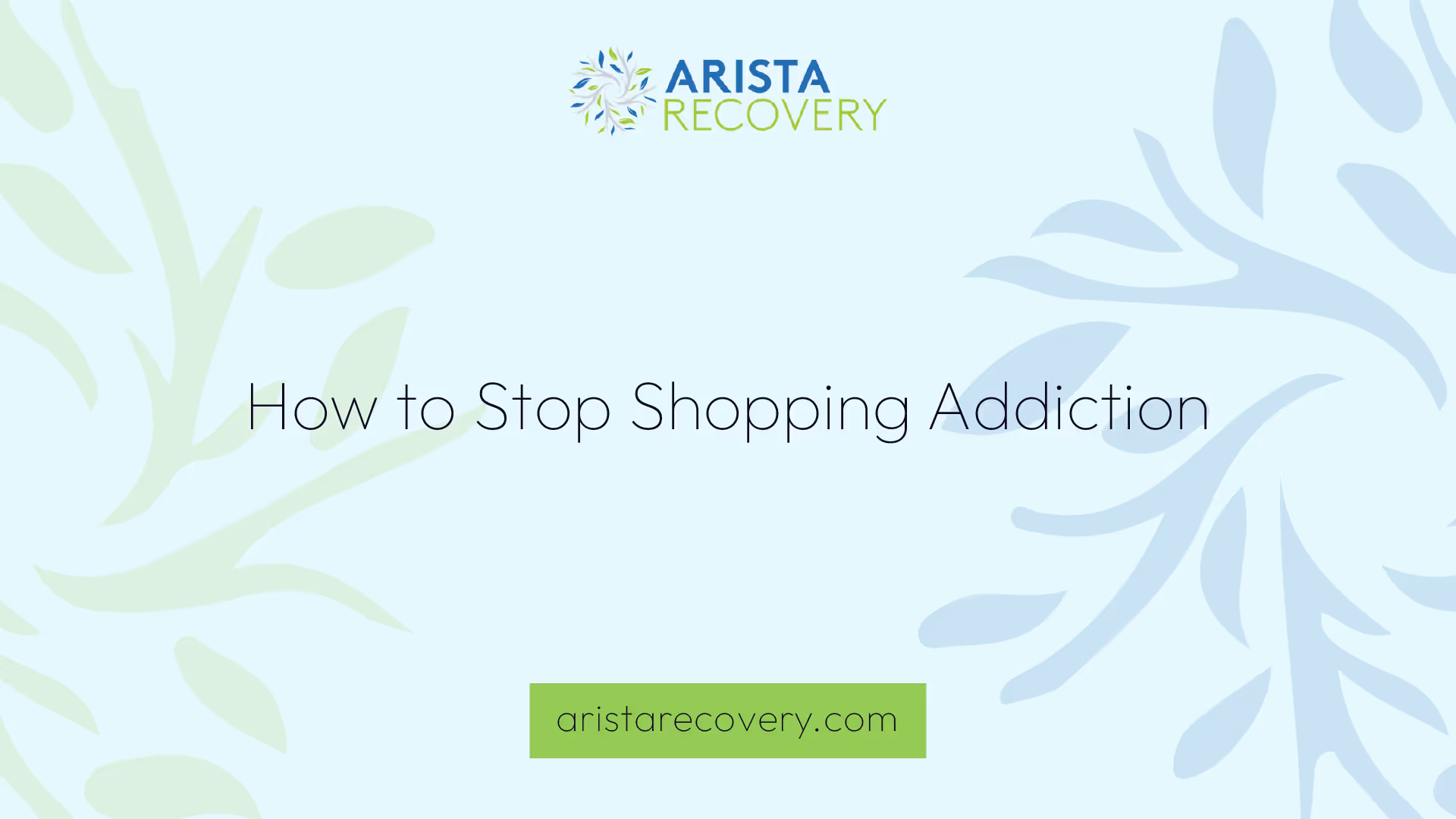How to Stop Shopping Addiction


Understanding Shopping Addiction
Definition and Characteristics
Shopping addiction, also known as compulsive buying disorder, is a behavioral addiction characterized by an overwhelming urge to shop and buy items, often to the detriment of one's financial, emotional, and social well-being. Individuals with this addiction use shopping as a way to feel good and avoid negative emotions such as anxiety, depression, boredom, and anger [1]. However, the relief provided by shopping is typically short-lived, leading to a cycle of compulsive behavior.
Key characteristics of shopping addiction include:
- Compulsive buying sprees
- Preoccupation with shopping
- Spending beyond one's means
- Hiding purchases from loved ones
- Feeling a rush of excitement when making a purchase, followed by guilt or remorse
Prevalence and Co-Occurring Disorders
Shopping addiction affects a significant portion of the population. Approximately 6% of the U.S. population is thought to have a shopping addiction, a figure that highlights the pervasiveness of this disorder in a consumer-driven society. The disorder often begins in late teens or early adulthood and is most prevalent among women and online shoppers.
Figures courtesy Verywell Mind
Shopping addiction frequently co-occurs with other mental health disorders. These include:
- Mood disorders (e.g., depression, bipolar disorder)
- Anxiety disorders
- Substance use disorders
- Eating disorders
- Other impulse control disorders
- Personality disorders
Understanding the prevalence and co-occurring conditions of shopping addiction is crucial for developing effective strategies to address the disorder. Individuals and families impacted by this addiction can benefit from seeking support and exploring treatment options, much like those dealing with other addictive behaviors. For related information, you can explore articles on how to stop gambling addiction, how to stop phone addiction, and how to stop sugar addiction.
Causes of Shopping Addiction
Shopping addiction, much like other forms of compulsive behavior, stems from a variety of causes. Understanding these causes is crucial for those looking to learn how to stop shopping addiction.
Psychological Factors
Psychological factors play a significant role in fueling shopping addiction. Stress and anxiety are often the most significant underlying causes. Many people turn to gratifying behaviors as coping mechanisms, as the endorphins released during shopping make individuals feel happy and less stressed [2]. This behavior can be further exacerbated by social isolation and stress, which were notably prevalent during the COVID-19 pandemic.
Moreover, shopping addiction can coincide with various mental health conditions. These may include:
- Obsessive-Compulsive Disorder (OCD)
- Personality Disorders
- Anxiety Disorders
- Binge-Eating Disorder
- Depression (Everyday Health)
The table below highlights the prevalence of these co-occurring disorders among individuals with shopping addiction:
Environmental Influences
Environmental factors also contribute significantly to the development of shopping addiction. Certain risk factors such as having a higher income, possessing credit cards, experiencing a divorce, or moving away from loved ones can influence emotionally driven compulsive buying.
Additionally, the modern digital landscape, with its constant bombardment of advertisements and easy access to online shopping, creates an environment where compulsive buying is more likely to occur. This, combined with social pressures and the desire to keep up with trends, can make it challenging for individuals to control their shopping habits.
It's also worth noting that shopping addiction can lead individuals to neglect essential responsibilities such as work, school, or family obligations. This neglect often results in ignoring loved ones, self-care, health, and work productivity due to excessive shopping [3].
For more insights into managing various forms of addiction, you may find it useful to read about how to stop phone addiction, how to stop sugar addiction, and how to stop gambling addiction.
Behavioral Patterns of Shopping Addiction
Impulse Buying
Impulse buying is a common behavioral pattern in shopping addiction. Individuals with this addiction often make unplanned purchases driven by a sudden urge, rather than a genuine need. This behavior can lead to significant financial strain and regret once the initial excitement fades.
Impulse buying can be triggered by various factors, such as:
- Sales and Promotions: Special offers and discounts often create a sense of urgency, prompting impulsive purchases.
- Visual Appeal: Attractive displays and packaging can entice individuals to buy items they hadn't planned on purchasing.
- Social Influence: Seeing others buy or use certain products can encourage similar behavior.
A table summarizing the triggers for impulse buying:
For more information on managing impulse buying, check out our article on how to stop gambling addiction.
Emotional Triggers
Emotional triggers play a significant role in shopping addiction. Many individuals turn to shopping as a way to cope with negative emotions such as anxiety, depression, boredom, and anger [1]. This behavior offers a temporary escape but can lead to long-term consequences, including financial hardship and guilt.
Common emotional triggers include:
- Stress and Anxiety: Shopping releases endorphins, which temporarily alleviate stress and anxiety.
- Loneliness and Social Isolation: Lack of social interaction can drive individuals to seek comfort in shopping.
- Depression: Shopping can provide a brief sense of pleasure, helping to distract from feelings of sadness.
A table summarizing common emotional triggers for shopping addiction:
Understanding these behavioral patterns is crucial for those looking to learn how to stop shopping addiction. By identifying and addressing impulse buying and emotional triggers, individuals can take significant steps towards overcoming this addiction and achieving emotional well-being. For additional strategies, consider reading about how to stop sugar addiction and how to stop phone addiction.
Strategies to Overcome Shopping Addiction
Addressing shopping addiction requires a multifaceted approach that includes behavioral changes and mindful practices. Here are some effective strategies to help individuals manage and overcome their shopping habits.
Delayed Purchases
One of the most effective methods to counter impulse buying is to practice delayed purchases. This technique involves postponing the purchase decision, allowing time for reflection and better judgment. The twenty-four-hour rule is a popular method where the individual delays the purchase by exactly twenty-four hours. This period includes a full day’s worth of challenges, joys, sorrows, and expenses, which helps avoid impulsive decisions and provides clarity on whether the item is really worth buying.
Applying the twenty-four-hour rule and other delayed purchase techniques can significantly reduce impulsive buying behaviors and lead to more thoughtful spending.
Mindful Shopping Techniques
Mindful shopping involves being fully aware of your shopping habits and making conscious choices. This strategy encourages individuals to focus on the quality and necessity of items rather than the quantity. By buying low-volume and high-quality items, individuals can develop a personal bond with their purchases, leading to a decreased reliance on buying more to feel happiness.
Using mindful shopping techniques helps individuals make more deliberate and satisfying purchases. This approach not only curtails excessive spending but also fosters a healthier relationship with shopping.
For those seeking additional support, exploring self-help groups and professional treatment options can provide further assistance in managing shopping addiction. Additionally, understanding the financial impacts of shopping addiction and creating an open dialogue about finances can aid in addressing the root causes of overspending.
Seeking Support for Shopping Addiction
When tackling shopping addiction, seeking the right support is crucial. There are various avenues available, including self-help groups and professional treatment options.
Self-Help Groups
Self-help groups provide a supportive environment where individuals can share their experiences and strategies for overcoming shopping addiction. These groups offer anonymous encouragement and tips for coping with compulsive shopping [6].
- Debtors Anonymous: Founded in 1968, Debtors Anonymous aims to help individuals stop incurring unsecured debt. The group shares experiences and offers support to other debtors. With over 500 registered meetings in more than 15 countries worldwide, it provides a global support network.
- Stopping Overshopping: An online program founded by April Lane Benson, PhD, offers services such as self-help programs, private coaching, and group coaching. This program is designed to help individuals regain control over their compulsive buying behaviors.
- Shopping Addiction Support Group: This online support group, with over 35,000 members, allows individuals to share their struggles and receive advice from others who have experienced similar challenges.
Professional Treatment Options
Professional treatment for shopping addiction often involves a combination of behavioral therapies and support groups. The goal is to identify emotional triggers, develop healthy coping skills, and regain control over shopping behaviors [3].
Seeking support is a critical step in overcoming shopping addiction. Combining self-help groups with professional treatment options can provide a comprehensive approach to managing and ultimately conquering the addiction. For more information on related topics, consider reading our articles on how to stop porn addiction, how to stop sugar addiction, and how to stop phone addiction.
Financial Impacts of Shopping Addiction
Shopping addiction can have profound financial repercussions, severely affecting an individual's economic stability and overall quality of life. The following sections detail the primary financial impacts of this addiction.
Debt Accumulation
One of the most significant financial consequences of shopping addiction is the accumulation of debt. Individuals with compulsive buying disorder (CBD) often find themselves in unmanageable amounts of debt, similar to the financial strains seen in gambling addiction. This can result in:
- Maxed out credit cards
- Inability to pay bills
- Loans taken to cover shopping expenses
The table below illustrates the average debt levels of individuals with shopping addiction compared to the general population:
Data: Addiction Center
The economic strain can lead to the loss of homes, cars, and a depreciated credit score, making it difficult to secure loans or mortgages in the future.
Neglect of Responsibilities
Shopping addiction can also result in the neglect of essential responsibilities. Individuals may prioritize shopping over important duties, including:
- Work obligations
- School assignments
- Family commitments
This neglect can lead to deteriorating relationships with loved ones, decreased work productivity, and compromised self-care and health. The following table showcases the areas most commonly neglected by individuals suffering from shopping addiction:
Data: Addiction Center
In addition, individuals with shopping addiction may hide their purchases from family members, feeling shame or embarrassment about their compulsive buying habits.
Understanding the financial impacts of shopping addiction is crucial for those seeking to overcome this disorder. For further information on related topics, visit our articles on how to stop sugar addiction, how to stop phone addiction, and how to stop porn addiction.
References
[1]: https://www.verywellmind.com/shopping-addiction-4157288
[2]: https://www.everydayhealth.com/emotional-health/what-is-shopping-addiction/
[3]: https://www.addictioncenter.com/community/signs-of-shopping-addiction/
[4]: https://www.forbes.com/sites/traversmark/2022/09/17/a-psychologist-offers-advice-on-how-to-overcome-shopping-addiction/
[5]: https://www.forbes.com/sites/andrewrosen/2023/11/02/when-a-shopping-addiction-impacts-your-savings/
[6]: https://www.verywellmind.com/self-help-groups-for-shopping-addiction-22351
[7]: https://www.theguesthouseocala.com/the-financial-destruction-of-shopping-addiction/
You’re not alone in this.
When mental health challenges and addiction intersect, it can feel isolating. At Arista, we offer compassionate, evidence-based, and trauma-informed care to help you heal, grow, and move forward.
You’re not alone in this.
When mental health challenges and addiction intersect, it can feel isolating. At Arista, we offer compassionate, evidence-based, and trauma-informed care to help you heal, grow, and move forward.
Support that moves with you.
You’ve taken a brave first step. At Arista Recovery, we’re here to help you continue with best-in-class care designed for long-term healing and support.
.webp)






